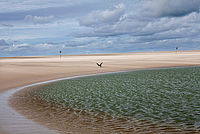MegaPEX2014
MegaPex stands for MEGA Perturbation EXperiment and is a six weeks field experiment is organized in the fall of 2014. The experiment is organised within the framework of NeMo and Naturecoast but is also supported through on-going Dutch research efforts and is open to national and international collaboration. During this experiment we aim to obtain insight into the feedback between coastal processes related to hydrodynamics, morphology, aeolian transport, dune formation, hydrology and ecology.The specific focus of the experiment is the development of a Mega Nourishment, The Sand Engine see Stive et. al. 2013, within a large coastal domain of 17 km alongshore.
Mega Nourishment
In 2011 the mega nourishment of 20 Mm3, named the Sand Engine, was constructed at the Delfland coast in The Netherlands. Both its volume and shape (a shore connected hook) are unprecedented in any coastal research and management program. The Sand Motor and adjacent coast accommodate a large variety in e.g. morphology, hydrodynamics and habitat within a relatively small spatial domain. Together with the historically well documented coastline, this large artificial perturbation provides an exciting new site for various disciplines of coastal research. Illustrative photo's of the project can be found here.
Monitoring
Since its completion, the Dutch government, universities and research institutes collaborate in monitoring and studying the behavior of the Sand Motor and adjacent coast. An unique inter-disciplinary dataset on hydrodynamics, morphology, ecology (marine and terrestrial) and hydrology is being built, containing monthly detailed bathymetry and topography data, Argus and radar data (since end of 2012), point measurements of velocity with ADCP’s and ecological data on fish and benthos populations.
Researchers are gladly invited to join in this challenging experiment in a unique environment. We look forward to the fall of 2014.
Involved Research Parties
- Delft University
- Utrecht University
- Imares
Researchers are gladly invited to inform about the possibilities to join this challenging experiment in a unique environment. We look forward to the fall of 2014.
Instruments
An overview of the instrument and locations can be found in this pdf.


